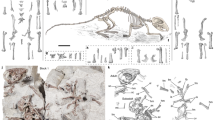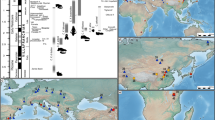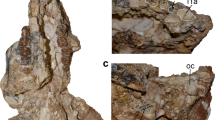Abstract
The vast majority of Mesozoic and early Cenozoic metatherian mammals (extinct relatives of modern marsupials) are known only from partial jaws or isolated teeth, which give insight into their probable diets and phylogenetic relationships but little else. The few skulls known are generally crushed, incomplete or both1,2,3,4, and associated postcranial material is extremely rare. Here we report the discovery of an exceptionally large number of almost undistorted, nearly complete skulls and skeletons of a stem-metatherian, Pucadelphys andinus, in the early Palaeocene epoch5 of Tiupampa in Bolivia6,7,8. These give an unprecedented glimpse into early metatherian morphology, evolutionary relationships and, especially, ecology. The remains of 35 individuals have been collected, with 22 of these represented by nearly complete skulls and associated postcrania. These individuals were probably buried in a single catastrophic event, and so almost certainly belong to the same population9. The preservation of multiple adult, sub-adult and juvenile individuals in close proximity (<1 m2) is indicative of gregarious social behaviour or at least a high degree of social tolerance and frequent interaction. Such behaviour is unknown in living didelphids, which are highly solitary and have been regarded, perhaps wrongly, as the most generalized living marsupials. The Tiupampan P. andinus population also exhibits strong sexual dimorphism, which, in combination with gregariousness, suggests strong male–male competition and polygyny. Our study shows that social interactions occurred in metatherians as early as the basal Palaeocene and that solitary behaviour may not be plesiomorphic for Metatheria as a whole.
This is a preview of subscription content, access via your institution
Access options
Subscribe to this journal
Receive 51 print issues and online access
$199.00 per year
only $3.90 per issue
Buy this article
- Purchase on Springer Link
- Instant access to full article PDF
Prices may be subject to local taxes which are calculated during checkout




Similar content being viewed by others
Change history
02 June 2011
Affiliation 2 was corrected.
References
Luo, Z.-X., Ji, Q., Wible, J. R. & Yuan, C.-X. An early Cretaceous tribosphenic mammal and metatherian evolution. Science 302, 1934–1940 (2003)
Rougier, G. W., Wible, J. R. & Novacek, M. J. Implications of Deltatheridium specimens for early marsupial history. Nature 396, 459–463 (1998)
Szalay, F. S. & Trofimov, B. The Mongolian Late Cretaceous Asiatherium, and the early phylogeny and paleobiogeography of Metatheria. J. Vert. Pal. 16, 474–509 (1996)
Horovitz, I. et al. Cranial anatomy of the earliest marsupials and the origin of opossums. PLoS ONE 4, e8278 (2009)
Gelfo, J. N., Goin, F. J., Woodburne, M. O. & de Muizon, C. Biochronological relationships of the earliest South American Paleogene mammalian faunas. Palaeontology 52, 251–269 (2009)
Marshall, L. G. & de Muizon, C. in Pucadelphys andinus (Marsupialia, Mammalia) from the early Paleocene of Bolivia (ed. de Muizon, C. ) Vol. 165, 21–90 (Mémoires du Muséum national d’Histoire naturelle, 1995)
de Muizon, C. Mayulestes ferox, a boryaenoid (Metatheria, Mammalia) from the early Palaeocene of Bolivia. Phylogenetic and palaeobiologic implications. Geodiversitas 20, 19–142 (1998)
de Muizon, C., Cifelli, R. L. & Céspedes Paz, R. The origin of the dog-like borhyaenoid marsupials of South America. Nature 389, 486–489 (1997)
de Muizon, C. & Céspedes, R. in Origins and Evolution of Cenozoic South American Mammals (eds Rosenberger, A. & Tejedor, M. ) (Springer, in the press)
Marshall, L. G., de Muizon, C. & Sigogneau-Russel, D. Pucadelphys andinus (Marsupialia, Mammalia) from the Early Paleocene of Bolivia (Mémoires du Muséum national d’Histoire naturelle, 1995)
de Muizon, C. in Fósiles y Fácies de Bolivia Vol. I Vertebrados Vol. 12 (3–4) (ed. Suárez-Soruco, R. ) 575–624 (Revista Técnica, Yacimientos Petrolíferos Fiscales Bolivianos, 1992)
Marshall, L. G., Sempere, T. & Butler, R. F. Chronostratigraphy of the mammal-bearing Paleocene of South America. J. S. Am. Earth Sci. 10, 49–70 (1997)
de Muizon, C. & Argot, C. in Predators with Pouches: the Biology of Carnivorous Marsupials (eds Jones, M., Dickman, C. & Archer, M. ) 42–63 (Surrey Beatty & Sons, 2003)
Atramentowicz, M. Dynamique de population chez trois marsupiaux didelphidés de Guyane. Biotropica 18, 136–149 (1986)
Tyndale-Biscoe, C. H. & MacKenzie, R. B. Reproduction in Didelphis marsupialis and Didelphis albiventris in Colombia. J. Mamm. 57, 249–265 (1976)
Cifelli, R. L. & de Muizon, C. Tooth eruption and replacement pattern in early marsupials. C. R. Acad. Sci. Ser. D 326, 215–220 (1998)
Astúa, D. Cranial sexual dimorphism in New World marsupials and a test of Rensch’s rule in Didelphidae. J. Mamm. 91, 1011–1024 (2010)
Fisher, D. O. & Cockburn, A. The large-male advantage in brown antechinuses: female choice, male dominance, and delayed male death. Behav. Ecol. 17, 164–171 (2005)
Kraaijeveld, K., Kraaijeveld-Smit, F. J. L. & Adcock, G. J. Does female mortality drive male semelparity in dasyurid marsupials? Proc. R. Soc. Lond. B 270 (Suppl. 2). S251–S253 (2003)
Soderquist, T. Spatial organization of the arboreal carnivorous marsupial, Phascogale tapoatafa . J. Zool. 237, 385–398 (1995)
Plavcan, J. M. Inferring social behavior from sexual dimorphism in the fossil record. J. Hum. Evol. 39, 327–344 (2000)
Hershkovitz, P. Composition of the family Didelphidae Gray, 1821 (Didelphoidea: Marsupialia), with a review of the morphology and behavior of the included four-eyed pouched opossums of the genus Philander Tiedemann, 1808. Fieldiana Zool. 86, 1–103 (1997)
Russell, E. M. Social behaviour and social organization of marsupials. Mammal Rev. 14, 101–154 (1984)
Oakwood, M. Spatial and social organization of a carnivorous marsupial Dasyurus hallucatus (Marsupialia: Dasyuridae). J. Zool. 257, 237–248 (2002)
Cáceres, N. C., Napoli, R. P., Lopes, W. H., Casella, J. & Gazeta, G. S. Natural history of the marsupial Thylamys macrurus (Mammalia, Didelphidae) in fragments of savannah in southwestern Brazil. J. Nat. Hist. 41, 1979–1988 (2007)
Lazenby-Cohen, K. A. & Cockburn, A. Lek promiscuity in a semelparous mammal, Antechinus stuartii (Marsupialia: Dasyuridae)? Behav. Ecol. Sociobiol. 22, 195–202 (1988)
Morton, S. R. Torpor and nest-sharing in free-living Sminthopsis crassicaudata (Marsupialia) and Mus musculus (Rodentia). J. Mamm. 59, 569–575 (1978)
Head, J. J. et al. Giant boid snake from the Palaeocene neotropics reveals hotter past equatorial temperatures. Nature 457, 715–717 (2009)
Acknowledgements
Field expeditions were supported by the National Geographic Society (grants 2908-84) in 1985 and by the ‘Institut Français d’Études Andines’ in 1997. The specimens collected are the property of the ‘Museo de Historia Natural Alcide d’Orbigny’ in Cochabamba, Bolivia. Additional financial support was provided by Research Project MO/36/020 of the Belgian Federal Science Policy Office (S.L.), and NSF grant DEB-0743039 (R.M.D.B., in collaboration with R. Voss at the American Museum of Natural History). Photographs are by C. Lemzaouda and P. Loubry, scanning electron microscope photographs are by J. Cillis and the reconstruction in Fig. 1 is by S. Fernandez. We thank E. Westwig for access to the AMNH collections, and O. Lambert, A. Pradel, and T. Soderquist for discussions.
Author information
Authors and Affiliations
Contributions
C.d.M. and R.C.-P. collected the specimens at Tiupampa. C.d.M. prepared the specimens. S.L. and C.d.M. initiated and organized the project. S.L., C.d.M. and R.M.D.B. wrote the paper. S.L., C.d.M., R.M.D.B., D.G. and R.C.-P. discussed the results and commented on the manuscript at all stages. Measurements were taken by S.L. and R.M.D.B. PCAs and ANOVAs were performed by S.L. and D.G.
Corresponding authors
Ethics declarations
Competing interests
The authors declare no competing financial interests.
Supplementary information
Supplementary Information
This file contains Supplementary Information including the referred material with catalogue numbers, the methods of measurements and the methods and results of the statistic analyses performed in this study. It also includes Supplementary Tables 1-3 and additional references. (PDF 3323 kb)
Supplementary Data
This file contains 17 Supplementary Tables which show measurement datasets and calculations. (XLS 378 kb)
Rights and permissions
About this article
Cite this article
Ladevèze, S., de Muizon, C., Beck, R. et al. Earliest evidence of mammalian social behaviour in the basal Tertiary of Bolivia. Nature 474, 83–86 (2011). https://doi.org/10.1038/nature09987
Received:
Accepted:
Published:
Issue Date:
DOI: https://doi.org/10.1038/nature09987
This article is cited by
-
Early mammalian social behaviour revealed by multituberculates from a dinosaur nesting site
Nature Ecology & Evolution (2020)
-
On the development of the chondrocranium and the histological anatomy of the head in perinatal stages of marsupial mammals
Zoological Letters (2017)
-
The Skull of Epidolops ameghinoi from the Early Eocene Itaboraí Fauna, Southeastern Brazil, and the Affinities of the Extinct Marsupialiform Order Polydolopimorphia
Journal of Mammalian Evolution (2017)
-
Reassessment of the Morphology and Taxonomic Status of the Earliest Herpetotheriid Marsupials of Europe
Journal of Mammalian Evolution (2012)
-
Ancient marsupials played possum in packs
Nature (2011)
Comments
By submitting a comment you agree to abide by our Terms and Community Guidelines. If you find something abusive or that does not comply with our terms or guidelines please flag it as inappropriate.



